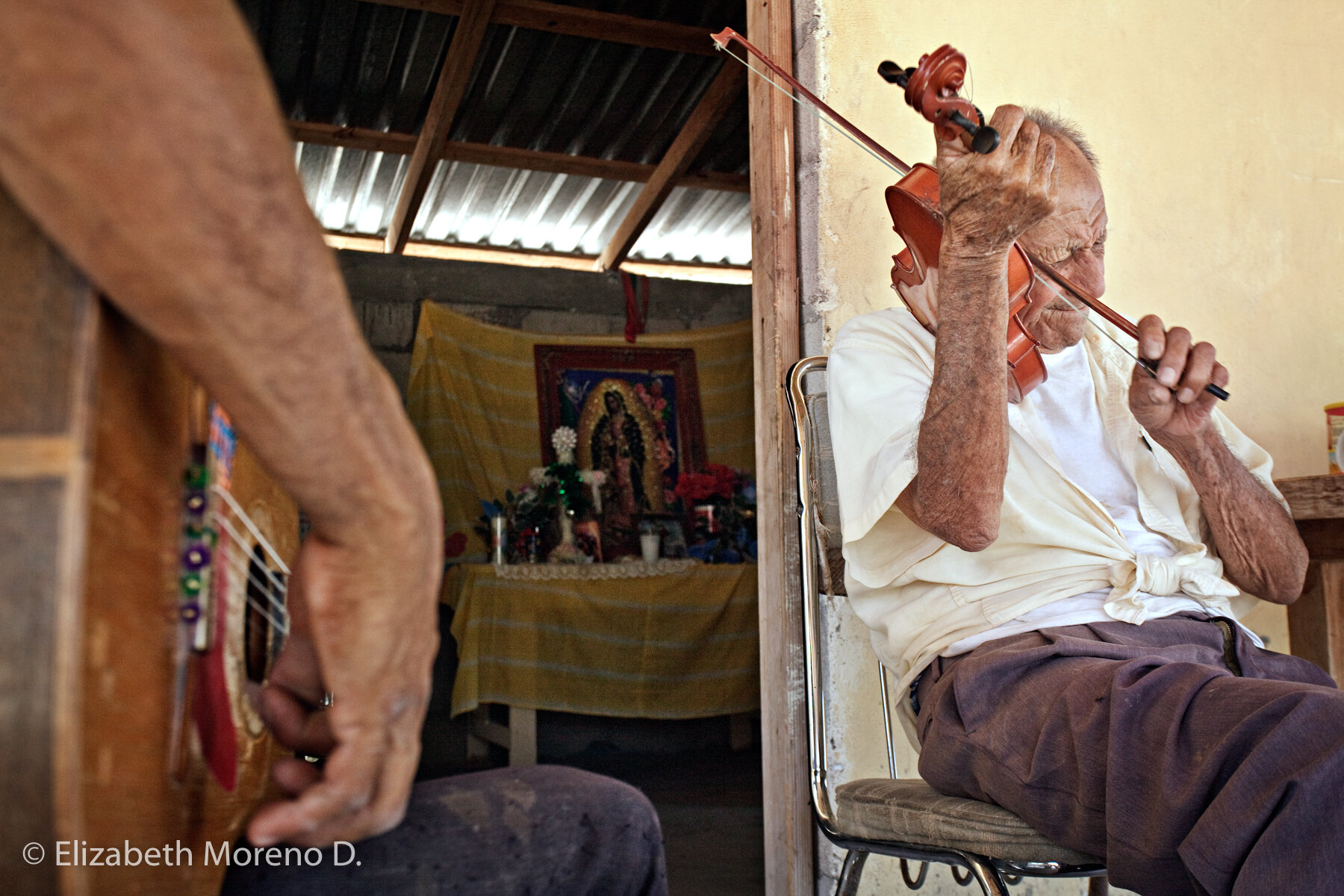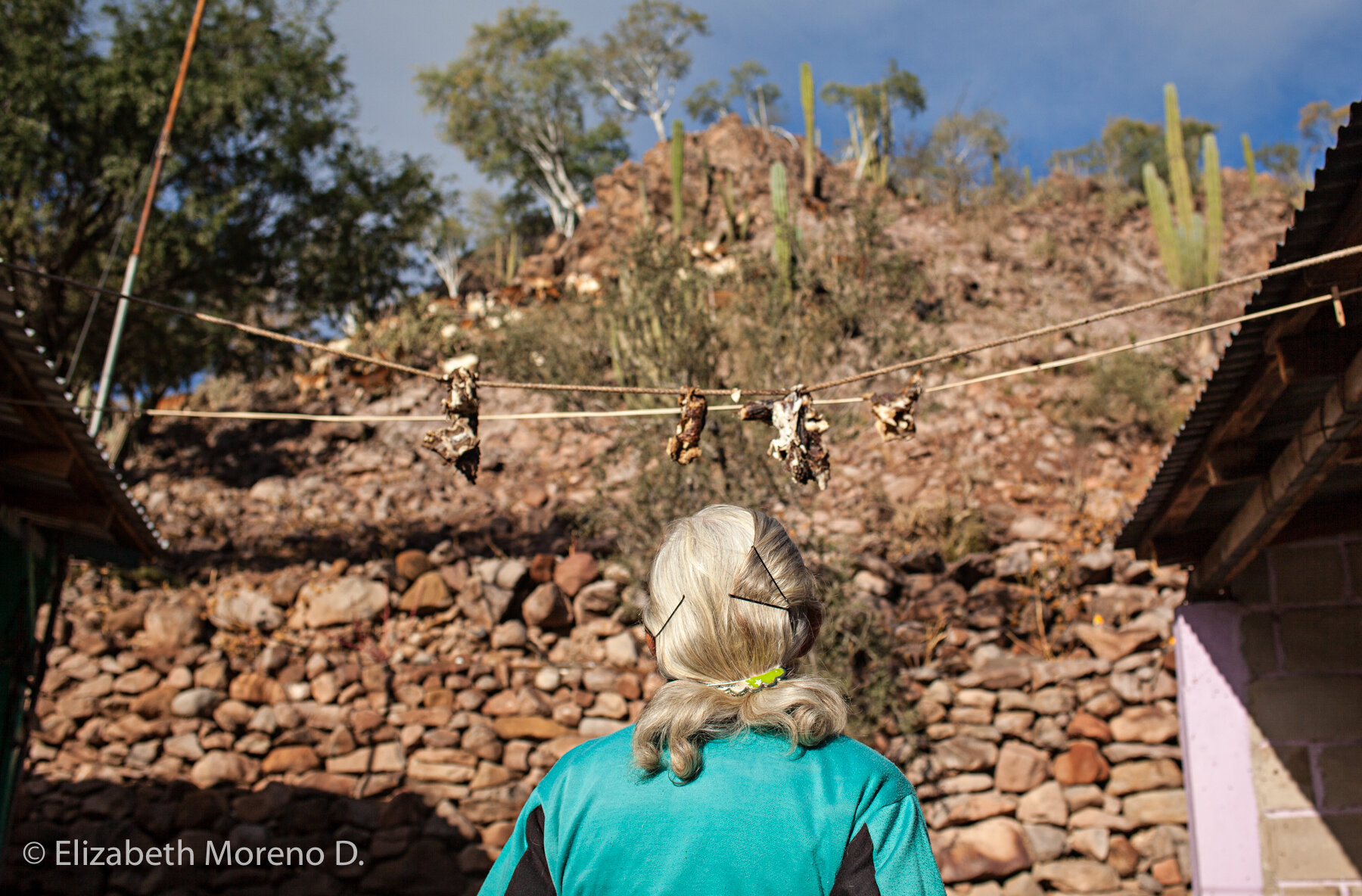Cerca de la tierra/ CLOSE TO EARTH WITH DOCUMENTARY PHOTOGRAPHER ELIZABETH MORENO AND THE RANCHEROS/ RANCHERAS OF BAJA CALIFORNIA SUR
By: Joy E. Stocke
Photography: Elizabeth Moreno
Cabo Pulmo, BCS. On a windless evening at the Visitor’s Center in the village of Cabo Pulmo on the Southeast Region of the Baja Peninsula, documentary photographer Elizabeth Moreno Damn, 36, projects photographs onto a screen. Moreno has photographed the lives of the rancheros and rancheras --the men, women, and children who live in the valleys of the Sierra la Giganta mountain chain-- for more than ten years. Some of whom are in the audience and seeing these photographs for the first time. For more than three hundred years, the rancheros and rancheras have raised cattle and sheep, worked the land and have remained almost entirely self-sufficient. The photographs and their stories are collected in Moreno’s new book, Cerca de la Tierra.
The following morning at the home of Deb Zeyen and Patricia Wright, founders of the Baja Coastal Institute, Moreno sits at a table on a porch overlooking the Sierra La Laguna Mountains. The mountains rise in counterpoint to the Sea of Cortes, their slopes vibrant green after abundant rainfall that has fallen well into the winter months.
Baja Costal Institute: You’ve been documenting the ranchero/ranchera way of life for more than a decade. How did you start?
Moreno: I grew up in San Pedro in the Sierra la Giganta north of La Paz. My house was more like a ranch. We had animals until I was eight or nine years old, and even though I went to school in La Paz, I grew up close to nature.
I used to travel to the ranches with my father. What I enjoyed most about those journeys was hearing my dad and the rancheros talking. I had the chance to listen to the rancheros’ amazing stories. I believed almost everything rancheros said. In a valley in the Sierra we used to visit a ranch close to a very large stone. The ranchero said the stone was sacred and the area, too, was sacred to the local Pericue Indians. The religious leader of the Pericue would go to the stone to receive knowledge and teachings about what to do to cure people.
The ranchero also talked about the mountain lions who roamed freely in the Sierras. But, in the 1920s, the government paid ranchers to kill mountain lions who were eating the cattle. He said there are still lions in the mountains and he has hunted for them. I told him I wanted to see a mountain lion in the wild. The ranchero had a little fluffy dog who, he said, was the best at getting the lions up the tree. But I never saw his dog catch one.
BCI: You are one of the few documentary photographers in Baja.
Moreno: It wasn’t considered a professional or a common career in Mexico. It was seen as a hobby, but in my mind, it was clear that this is what I would do. I studied in Tijuana, but I found a two-year photography program in Colorado, in Glenwood Springs. From there I got a job at Anderson Art Center in Snowmass, Colorado. I had the privilege of making fine art prints for outdoor and nature photographer Norm Classen (famous for creating the iconic photographs featuring the Marlborough man). I learned to “see” during those years. In 2008, I returned to la Paz and began photographing the ranches.
I noticed huge changes in the places I visited as a child; in La Paz, specifically, but everywhere in Baja California Sur. And, so, I applied for a local state grant, which allowed me to begin my photography work. In 2010, I applied for a Federal grant. Cerca de la Tierra is the fruit of the that grant and the support of others.
BCI: What has changed the most since you started the project?
Moreno: The Peninsula, although mountainous, created a unique environment. The ranches are not really far from the coast. But until very recently and (still in some places) there was no internet, no phones. You accessed the world by traveling on dirt roads. You sent messages. If a person would drive out you would ask them to let another ranch know that you needed cattle or supplies. Or, you would communicate via CB radio.
Ranch communities vary in size, consisting of one house with a couple and their kids to a group of houses from the same family of up to thirty or forty people with five or six houses. People look after one another. And they rely on themselves to provide services for which we would go to a doctor.
For instance, if someone was hurt or sick you often couldn’t get to a hospital. You would go to the local healer who knew the old remedies. I met a lady who inherited “the cure” for rabies – but she won’t tell how she does it. People still go to her.
BCI: Cattle are obviously not native to the Baja Peninsula.
Moreno: No. The ranches grew from missionaries who, in 1697, set up their first community in Loreto, north of La Paz. The missionaries brought the cattle to serve as food and to provide milk; and, of course, they brought people to care for the animals. They brought farmers, cooks, builders, people who made clothes. After the missions collapsed, the farmers and workers looked for places to live and moved to the mountains where there was water, and where they built their ranches. From there, the ranchero/ranchera population spread up and down the Peninsula. The ranchero/ranchera way of life remained stable for three hundred years. Perhaps once or twice a year, if they went at all, the rancheros would travel north to Loreto or Mulege on the Sea of Cortes to trade goods.
People didn’t start to leave the ranches until the 1950s and this was a gradual process. In Cd. Constitución o Valle de Santo Domingo, agriculture took over and it became attractive to the ranchers, especially younger adults looking for work. Also, property rights started to be recognized. And a lot of the ranches didn’t have papers for their land. And since they weren’t registered anywhere, the people who left to work in places like Contitución, lost their land. To this day a number of rancheros don’t officially own the land they’ve ranched for a century or more.
BCI: How are the ranches surviving today?
Because of the difficulty of ranch life, ranches have been in danger of collapsing, but tourism, at least in the south, has helped the ranches. With the advent of off road racing, like the Baja 1000, ranches have found a way to earn an income by selling food along the highway, or they help dig out cars. In the process, the dirt roads get beat up, cattle get killed, and without direct support from the government the rancheros fix the roads by hand.
Also, they are happy to have visitors. They enjoy people and offer you everything they can. Their knowledge is undervalued. Here they have knowledge about plants, about leather-working, animal husbandry, medicine passed down through generations. At the same time, they feel they don’t know enough. In fact, they often feel like they don’t know anything. But they have knowledge we don’t know.
I admire their deep knowledge of the environment, something we totally lost in the city. Most people who live in the city don’t care if there’s wind or if the doves are singing in a certain way. Our environment is our cars or our air-conditioned houses.
The rancheros and rancheros still know how to read the clouds and predict the weather. They know what the birds say when they sing. They’ve learned through the years that if the clouds follow a certain pattern it will rain in a month. They know that when the ciruelo (native plum) trees flower too early, there will be a drought. They know their environment so well, they don’t feel separate from it at all.
Most important, they were able to find water, dig wells, water their fields. They have drunk that water for decades. And their water is very clean and rich in some minerals.
BCI: Your book has been published at a time when there’s been some success with conservation, particularly in Baja California Sur, and specifically the Southeast Region.
Moreno: There is so much we’re going to lose if we don’t listen to the people who have been here for generations. But it’s very hard to get them to share their knowledge. They live and breathe it, so they don’t fully realize they have it. I’ve heard of one person who has been doing research about the use of plants. She works for the university in La Paz. She has a botanical garden with local native plants. From what I know, she’s been doing research on how to use plants to cure illnesses.
BCI: You’ve shared how the advent of television and cell phones has changed the ranch communities.
Moreno. Yes, you could say the television parted the waters. In the long run, history will see it as the dividing line in the culture of the rancheros. First tv and now cell phones. I noticed, in 2010, that a dish company had started installing satellites and making hardware available. That broke the old chains of communication. The children are no longer listening to the stories, they are losing knowledge about the environment. Also, until 40 or 50 years ago, the rancheros relied on travel by horseback. They recycled everything. Now, that there are cars and trucks, waste has been accumulating.
BCI: Do you think the ranches will survive?
Moreno: I don’t think the ranches will disappear – there will be a few families who want to stay. When I asked the question to one of the rancheros, he tapped his son’s head, and said, “We will continue.” He and his wife are happy with their lives, but who knows what will happen with the next generation.
Those who study the rancheros say that there are not enough young people getting married and staying. But, about ten years ago, the government began to recognize the ranchero culture. The most visually interesting thing from the ranches was the cowboy dressed in leather, traditional cowboy, and image from movies. But, really, if you see these cowboys, you’ll understand that the movies copied them.
BCI: Recently, I had the opportunity to take an excellent cooking class at a ranch in San Bartolo, north of Los Barriles and near El Triunfo. The women were expert at working a complex wood-fired grill and were in full control.
Moreno: In popular culture, it’s more romantic to picture a cowboy roping cattle or hunting in the brush. The women took a second place. About eight years ago, I began to look at the women, giving them the importance they deserve.
They’re always at the ranch caring for the family, milking the cows and goats, making cheese, educating the children, or seeing that their children get to school. The ranchero might go out for months to gather cattle in the mountains and deliver them to the coast.
The women stay there by themselves taking care of the kids doing all the labor of the ranch. They rise at five am in the morning to get firewood while the kids are sleeping. After milking chores, they make breakfast for the family, take care of hens, wash the clothes.
They take a siesta at mid-day because it’s hot and because they need to care for the ranch until the last child goes to bed. Tourists come and see them resting and think they are lazy. The don’t have washing machines. They don’t have ovens. They somehow get it all done and often with humor.
BCI: What is your hope for the future of the rancheros and rancheras?
Moreno: From the outside, I can say that I hope the new generations use their new technologies to start new things that improve the lifestyle they already have. They enjoy a very good quality of life but, of course, there’s a lot of hard work that can benefit from technology. Turn the coin around. The key for the new generations is that they feel proud about their heritage and that they want to make a difference. They have a lot of opportunities to build pride in their culture.
BCI: What are your plans for the future?
Moreno: I’ll keep visiting the ranches and documenting them. This book is the first chapter. I want to do a project focusing on the southern district, Santiago, Miraflores, the Southeast Region. There is more rain here and the weather makes for different ranches. Tourism is developing at a fast pace. And that makes for different people.
I plan to bring more of the books to the rancheros and communities. I have given some already, and they like it. One of the younger kids who is studying in La Paz works with us. He was telling us the other day that his family shows visitors the book. It was nice to hear that from him how they feel.












